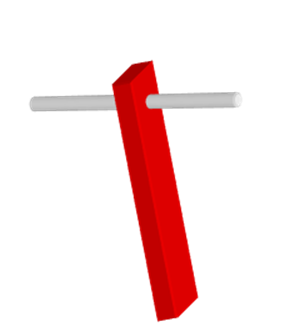Driven Damped Pendulum III: Log Separation and Lyapunov

As in the previous applet II , we follow two trajectories for a damped driven system. The trajectories have all parameters except the initial angle identical.
We plot the logarithm to base 10 of the absolute angular difference as a function of time (following Taylor).
For small driving force, the behavior is close to that for the driven damped linear oscillator discussed in a previous applet: the separation of the two trajectories as a function of time is a damped oscillation, close to Keλtsinωt with negative λ. Taking the log of the absolute value will give a bumpy curve: at each zero, the log curve of course goes to minus infinity. However, just focus on the peaks: they lie on a straight line (well, approximately). The slope of this line, λ, is the Lyapunov exponent. (Note, though, that our graph, following Taylor, plots log to base 10 and time in cycles, so our slope is a constant factor times the usual Lyapunov exponent.)
The Lyapunov exponent is negative if the behavior is nonchaotic, but becomes positive with the onset of chaos, and in that regime, unsurprisingly, the curves become more noisy—but nevertheless the exponent is often clear.
Walk-Through
Press Play: the preset values are: 2.25, 1, 0.75, 1.07, 0.0005, 5, -1.5708, -1.5709, vertical axis 0.2 are chosen to reproduce Taylor’s fig 12.12 (although starting lower). This is γ = 1.07, period doubled but nonchaotic motion. The average difference between the two curves decays exponentially, measure the slope by moving the red line around.
If you want to get the slope more quickly, up the play speed: this doesn’t affect accuracy, just the number of dots displayed.
Setting the drive strength at γ = 0.9, we can see much more rapid exponential decay over 12 orders of magnitude, at which point the accuracy of our calculation breaks down.
Going into the chaotic regime, the exponential decrease changes to exponential increase. Try a few values!
To get Taylor's fig 12.13, γ = 1.105, initial angles -1.5708, -1.5709. vert scale 0.5, horiz scale 0.25, dt = 0.01 msec, speed = 50, say.
Here's the relevant lecture, which includes more details.
In the next applet, we'll plot the pendulum's path in state space.
Program by: Carter Hedinger
